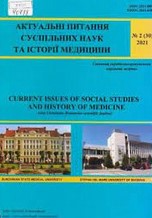ФЕНТЕЗІЙНА ІНТЕРПРЕТАЦІЙНА МОДЕЛЬ У ТВОРАХ СУБЖАНРУ “ІСТОРИЗОВАНЕ ФЕНТЕЗІ + ЕЛЕМЕНТ АІ”
FANTASY INTERPRETATION MODEL FOR HISTORIOGRAPHY FANTASY NOVEL PLUS AH SUBGENRE
Author(s): Anatoliy KOTSUR, Antonina AnistratenkoSubject(s): Theory of Literature, American Literature
Published by: Видавництво ВДНЗ України « Буковинський державний медичний університет »
Keywords: Alternative history; Fantasy novel plus AH subgenre; fiction novel; Fantasy Interpretation Model; literary genre study; “Game of Thrones”; “Queens don’t have legs”;
Summary/Abstract: Taking into account the different goals of the AH and Fantasy novel plus AH subgenre writing, we can try and develop one definition of both. AH writing reconstructs the national or world history and the changed facts, conclusions draw our attention to specific facts, key moments of well-known stories that are invisible for us, since of everyday life’s obvious reality prevents us from analyzing processes, we turn on the automatic mode instead. While Fantasy novel plus AH subgenre writing is rather monumental work, because it turns to the world history or historiography model making. Fantasy novel plus AH subgenre works use the historyographical method, but they exist in unreal time dealing with well-known constructions of the action world history of civilization. For example, one of the first uchronic stories by George Richard Raymond Martin “The Hedge Knight” (Martin) uses the space of Middle Ages in Europe for fiction story modeling. Also, it is an abstract of the world of the latest “Game of Thrones” – the greatest fiction saga of the new age literature in the 2000s. There is no doubt that “A Song of Ice and Fire” is constructed based on the matrix of such myth as “The Elder Edda” and “The Lord of the Rings” by John R. R. Tolkien. Legendary fantasy writer J. R. R. Tolkien spent much of his life studying, translating, and teaching ancient tales of northern Europe at Oxford and drew on them for his own writing. These epic stories, with their wizards and knights, dragons and trolls, cursed rings and magic swords, are as fascinating today as they were thousands of years ago. Reading them brings us as close as we will ever get to the magical worlds of the Vikings and the origins of their twentieth-century counterpart: Tolkien’s Middle Earth gave G. R. R. Martin, according to his own confession, the idea of the fantasy world of Westeros. The article deals with the specifics of the Fantasy novel plus AH subgenre in comparison to the Alternate history itself. The aim of the study is to emphasize the main features of the Fantasy novel plus AH subgenre and its common and different characteristics. The study uses such a method as comparative, descriptive, analysis and statistics counting. The novelty of the current research is realized by the essence of the first-time study of the AH subgenres on the world literature sources. The sources of the study are novels written by G. R. R. Martin “A Song of Ice and Flame”, “Kaiser and the War” by Simon J. Ortiz and V. Neff “Queens Don’t Have Legs”. Conclusions. As well as “A Song of Ice and Flame” by G. R. R. Martin, V. Neff’s trilogy exhibits a gallery of kings, queens, dukes, wizards, captains, people. Some of them are real, some are prototypes of actual statesmen; some characters come from Greek myths, while some – from the author’s fantasy. Although the objective of the alternative history method in the both works is quite different, it plays a similar role in the plot construction. Alternative history builds the walls of fantasy world from the bricks of actual historical elements, making the novel interesting for readers and involving them as betrayers.
Journal: Актуальні питання суспільних наук та історії медицини
- Issue Year: 2022
- Issue No: 2
- Page Range: 104-108
- Page Count: 5
- Language: Ukrainian

